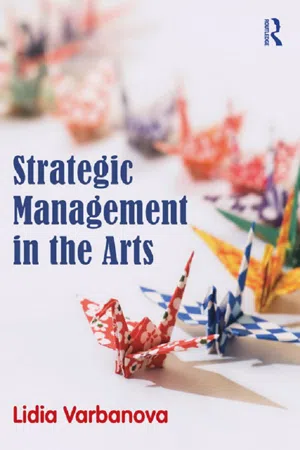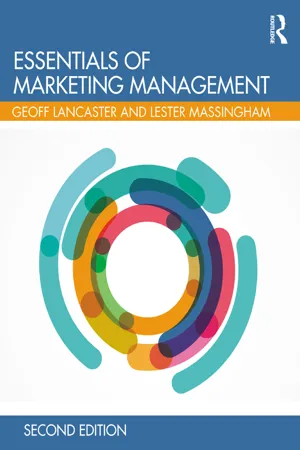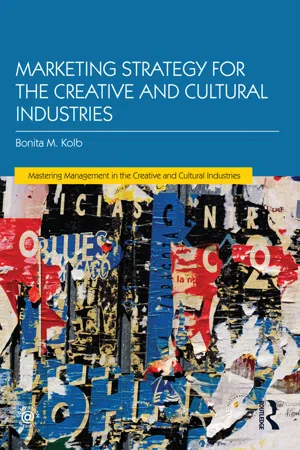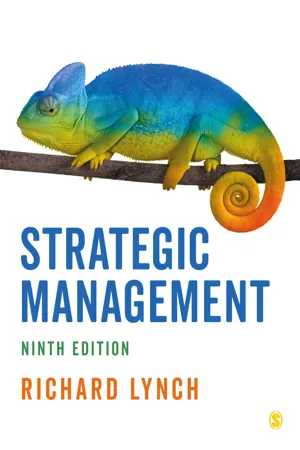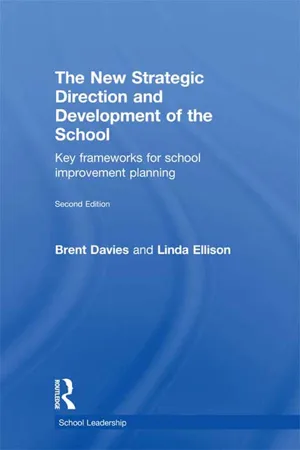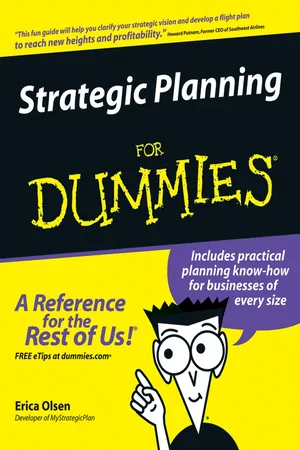Business
Strategic Analysis
Strategic analysis involves the evaluation of an organization's internal and external environment to identify its strengths, weaknesses, opportunities, and threats. This process helps in formulating effective strategies to achieve the organization's objectives and gain a competitive advantage in the market. It typically includes assessing market trends, competitor analysis, and SWOT analysis to make informed decisions.
Written by Perlego with AI-assistance
Related key terms
Related key terms
1 of 4
Related key terms
1 of 3
11 Key excerpts on "Strategic Analysis"
- eBook - ePub
- Lidia Varbanova(Author)
- 2013(Publication Date)
- Routledge(Publisher)
The Arts Organisation and Its EnvironmentLEARNING OBJECTIVESUpon completing this chapter you should be able to:- Demonstrate why Strategic Analysis is a key phase in the strategic management process.
- Articulate the differences between macro- and micro-environmental factors and the influence they have on an arts organisation’s performance.
- Understand cultural policy and creative (entertainment) industries as key elements of the external environment.
- Elaborate competitor analysis and stakeholder analysis.
- Elaborate the SWOT matrix in preparation for selecting the right set of strategies.
- Analyse driving and restraining forces as a result of interactions between various factors.
- Elaborate a SWOT analysis section of a strategic plan.
1. Strategic Analysis: AN OVERVIEW
Strategic Analysis is an important phase in the overall strategic management process. In practice it is inseparable from strategic thinking because the formulation of the mission, vision and strategic goals should be in line with the results of the analysis of the present situation. As discussed in Chapter 2 , strategic planning reflects the changing relations between an organisation and its environment over a long period of time and suggests ways of achieving an organization’s mission and objectives by choosing the most appropriate strategies and action tools1 .Like every other organization, an arts organisation does not operate in a vacuum and is surrounded by the outside world which in economics, management and marketing studies is called the external environment or context. The external environment includes all factors which are outside of an arts organization but influence its resources (input), processes and/or outcomes (results). Some of these factors have a closer influence and are part of the direct (micro-) external environment, while others form the macro-framework as their influence is indirect (see Figure 5.1 - eBook - ePub
Managing Strategy
Your guide to getting it right
- Chartered Management Institute(Author)
- 2014(Publication Date)
- Profile Books(Publisher)
Performing a SWOT analysisWhile his work is academically rigorous, his ability to abstract his thinking into digestible chunks for the business world has given him wide appeal in both the academic and business worlds. It is now standard practice for organisations to think and talk about value chains, and the five forces have entered the curriculum of every management programme. Porter’s later thinking on strategy rides the new wave of revolutionary strategic thinking led by Hamel and links consistently with his earlier work. One suspects not only that there is more to come from Porter, but also that it will be wholly consistent with what he has said in the past.SWOT analysis is a diagnostic tool for strategic planning which involves the identification and evaluation of strengths, weaknesses, opportunities and threats. This framework facilitates the assessment of internal capabilities and resources that are under the control of the organisation and of external factors that are not under organisational control. SWOT analysis involves the collection of information, rather than the framing of recommendations, which can only be considered once the facts have been confirmed. The analysis may be carried out by a single manager, but it usually involves the participation of a wider group, so that insights can be gained from across the organisation or department.SWOT analysis emerged in the 1960s from research at Stanford Research Institute into the failure of current corporate planning methods. The technique evolved, became widely used during the 1980s and remains popular, although critics have pointed out weaknesses in its application, including a lack of analytical depth. It provides a simple framework for analysing the market position of an organisation and can be applied in a range of planning and strategic contexts including strategy development, marketing planning, and the evaluation of strategic options for a whole business or an individual department. It may be used in conjunction with tools such as PEST (political, economic, social, technological) analysis, or one of its variants, or five forces analysis, which can provide a deeper understanding of the external environment and help to assess potential risks and threats to the profitability and survival of the organisation. SWOT analysis is also used by individuals to assess personal career prospects, but this checklist focuses on its use by organisations and departments and does not cover the individual aspect. - eBook - ePub
Business Analysis Techniques
123 essential tools for success
- James Cadle, Debra Paul, Jonathan Hunsley, Adrian Reed, David Beckham, Paul Turner(Authors)
- 2021(Publication Date)
- BCS, The Chartered Institute for IT(Publisher)
This chapter describes a range of techniques for carrying out Strategic Analysis and definition, plus techniques to monitor ongoing performance. The following four areas are covered:- strategy analysis, including external environment and internal capability;
- strategy definition;
- strategy implementation;
- performance measurement.
Organisations must assess and address changes that have arisen, or can be predicted to arise, within their operating business environment. Such changes occur constantly, and any organisation that fails to identify and respond to them runs the risk of encountering business problems or even the failure of the entire enterprise. Senior management should carry out regular monitoring of the business environment in order to identify any influences that may require action.The techniques covered in this section are:- PESTLE analysis;
- Porter’s five forces analysis.
These techniques are used to analyse the internal capability of an organisation to gain insights into its areas of strength and its inherent weaknesses, and to identify possible strategic approaches available to the organisation.The techniques covered in this section are:- Ansoff’s matrix;
- growth share matrix;
- resource audit;
- VMOST analysis.
During strategy definition, the results of the external and internal environmental analyses are summarised and consolidated in order to examine the situation facing the organisation and identify possible courses of action. When defining the business strategy, the factors outside the management’s control are examined within the context of the organisation and its resources.The techniques covered in this section are:- business model canvas;
- cultural web;
- business capability model;
- information concepts model;
- SWOT analysis.
- eBook - ePub
- Geoffrey Lancaster, Lester Massingham(Authors)
- 2017(Publication Date)
- Routledge(Publisher)
However, the word ‘environment’ encompasses many factors, often complexly linked, which affect the survival of any enterprise. Specifically, this chapter examines the range of environmental factors, discusses how to assess the impact of these factors, and suggests a framework for environmental scanning. The identification of opportunities and threats represents one half of SWOT analysis. The other half entails the appraisal of organizational resources in order to ascertain strengths and weaknesses. As shown in Chapter 1, assessment of possible opportunities and threats and the appraisal of strengths and weaknesses make sense only if we consider both internal and external factors together. It is difficult for the individual company to assess the strategic implications of environmental trends and changes and the extent to which they will pose opportunities or threats without considering these trends and changes in the context of organizational resources. In addition, the selection and implementation of strategies are dependent on organizational strengths and weaknesses. Resource analysis and assessment of organizational strengths and weakness that stem from this analysis are a key task of strategic marketing management - eBook - ePub
- Debra Paul, James Cadle, Malcolm Eva, Craig Rollason, Jonathan Hunsley(Authors)
- 2020(Publication Date)
- BCS, The Chartered Institute for IT(Publisher)
A key point that emerges from these examples is that strengths and weaknesses are found from within the organisation. They are discovered following an analysis of the VMOST, performance, the resource audit and the portfolio of products. In contrast, opportunities and threats are from outside the organisation and are found using the PESTLE or the Five Forces Model. The external factors that present opportunities and threats cannot be influenced by the organisation. It is the decisions about whether or not to grasp opportunities or deal with threats that are within the control of the organisation. The ability of the organisation to make decisions on how to respond to factors presenting opportunities and threats depends upon the internal strengths and weaknesses. Typical decisions may be:- to develop new products and services for the existing market;
- to move into new markets;
- to introduce a new marketing or sales strategy and increase the share of existing markets;
- to diversify into new product areas that open up new markets.
There are various aspects to consider when executing an organisational strategy. These include the results of the internal and external environment analysis and the gap between the organisation’s current and desired target state. There are several techniques that may be used to inform strategy development and execution, in particular:- business model canvas (BMC);
- business capability model (BCM);
- value stream modelling;
- target operating model (TOM).
The term ‘business model’ has several meanings. It is used to refer to the way an organisation is designed to deliver products and services to customers. This provides a means through which to develop and execute strategy.Business models help to align the work of the organisation with desired outcomes. They can be used to assess the current and target state and to identify and plan changes. - Bonita M. Kolb(Author)
- 2016(Publication Date)
- Routledge(Publisher)
5Establishing strategic goals, objectives, and tacticsThis chapter will answer the following questions
- What is the process of determining the organization’s future strategic plan ?
- How is a SWOT analysis used to make sense of the organization’s internal resources, external environmental factors, and consumer research findings?
- Why is determining the organization’s competitive advantage critical to success?
- How are strategic actionable goals, objectives, and tactics developed?
The chapter in a few words
- The strategic plan is critical to success as it will get everyone in the organization involved in moving in the same direction to achieve the same goal. To ensure that everyone supports the plan, all employees should be involved in its creation.
- From internal analysis, external environmental scanning, and consumer research, the organization will now have a great deal of data on which to base decisions. The problem is how to make sense of all of this information. A SWOT analysis will help organize this data into strengths, weaknesses, opportunities, and threats. The organization can then match an internal strength with an external opportunity.
- From the completed SWOT, the organization will be able to determine the competitive advantage of both the organization and the product. The organizational competitive advantages can be based on Porter’s generic strategies of differentiation, low price, or focus. The values discipline strategies that can be used are product leadership, operational excellence, or customer intimacy. In addition, the product might be the source of the organization’s competitive advantage.
- With the competitive advantage in mind, the organization can write a goal, objectives, and tactics
- Available until 29 Sep |Learn more
- Richard Lynch(Author)
- 2021(Publication Date)
- SAGE Publications Ltd(Publisher)
This is explored further in Chapters 4 and 14. Key Strategic Principles Environmental analysis can usefully begin with a basic assessment of the market definition and size, the market growth and the market share. Market definition is important because it will determine the size and scope of the strategic opportunity. Market definition will be defined by a consideration of customers and the availability of substitute products. Market growth is commonly estimated early in any Strategic Analysis because of its importance with regard to the growth objectives of an organisation. A basic estimate of market share can be used to estimate whether an organisation has a significant share of a market as a starting point in exploring the strategic implications. 3.3 Degree of Turbulence in The Environment 8 At the general level of environmental analysis, it is important to consider the basic conditions surrounding the organisation. Special attention needs to be directed to the nature and strength of the forces driving strategic change – the dynamics of the environment. One reason for this consideration is that, if the forces are exceptionally turbulent, they may make it difficult to predict and use some of the analytical techniques – like Porter’s ‘Five Forces’, discussed later in this chapter - eBook - ePub
- Rob Dransfield(Author)
- 2013(Publication Date)
- Routledge(Publisher)
6 Business strategy in an economic contextChapter Outline6.1 Introduction6.1 Introduction6.2 What business strategy involves6.3 The ingredients of strategy6.4 The criteria for an effective strategy6.5 How an environmental analysis helps to determine the suitability of a strategy6.6 The nature of strategic vision, objectives, focus and architecture6.7 Business strategy in an economic context6.8 SummaryChapter ObjectivesBy the end of this chapter you will understand:- Why businesses need to have an effective strategy
- The components that need to be in place to create a business strategy
- How to judge a strategy in terms of suitability, acceptability and feasibility
- How to create a PEST analysis
- Why it is important to evaluate the economic environment and its impact on business strategy
Businesses need to have a sense of the direction in which they want to move. Once they are clear about this they can formulate their plans – strategies to achieve their desired goals. However, the process is not as simple as it sounds. Businesses operate in uncertain environments. They need therefore to be continually prepared to adjust their strategies to accommodate for environmental change.Perhaps the biggest uncertainty in the business environment is economic change. This is one of the reasons why an understanding of economics is so important to business students. You need to be able to understand the impact of major macro-economic changes such as changes in the gross domestic product (GDP) of a country, and the relative growth of different economies. This chapter therefore explores corporate strategy in the context of an uncertain economic environment. It illustrates the sorts of strategies that businesses have employed to survive and prosper against a background of economic uncertainty. - eBook - ePub
Benefits Management
How to Increase the Business Value of Your IT Projects
- John Ward, Elizabeth Daniel(Authors)
- 2012(Publication Date)
- Wiley(Publisher)
Public sector and not-for-profit organizations must also constantly scan the external environment and take account of their internal resources and capabilities, in order to develop strategies that best meet the needs of their various constituents or stakeholders. Indeed, such organizations often have a large number of stakeholders, whose expectations and needs may at times be conflicting. This creates the additional challenge of balancing the needs of these different stakeholders in an acceptable and achievable way. The tools and frameworks presented throughout this book are suitable for use by both private and public sector organizations. However, it may be appropriate in some cases to change the terms used in the latter case; for example, rather than use the term ‘customer’, substitution of the word ‘citizen’ or ‘client’ may be more appropriate.The External and Internal Perspectives of Business Strategy: the Competitive Forces and Resource-Based Views
All organizations are interested in finding ways in which they can ensure their long-term viability, whether they are companies looking to maximize their shareholder value or public sector and not-for-profit organizations seeking to maximize their effectiveness. In that context, a business strategy can be described as ‘an integrated set of actions aimed at increasing the long-term well being and strength of an enterprise’ (Porter, 1980).A number of tools and techniques to guide and structure the formal development of corporate strategies were developed during the 1960s and 1970s. Some of these, such as the Boston Consulting Group’s grid or matrix, are still proving useful today. These approaches encouraged the analysis of factors affecting the attractiveness of the markets in which the company operated or was considering entering. This emphasis on the external environment was continued by Porter (1980; 1985), who suggested that there were structural factors and forces acting within industries and markets that resulted in some offering a greater potential for profitability or growth (see the later discussions of five forces and value chain analysis). Organizations should therefore identify these more attractive industries and markets and the factors affecting profitability and then select appropriate strategies, such as ‘low cost’ or ‘differentiation’ in order to outperform competitors. This approach to strategy development is referred to as the ‘competitive forces’ view of strategy. - eBook - ePub
The New Strategic Direction and Development of the School
Key Frameworks for School Improvement Planning
- Brent Davies, Linda Ellison(Authors)
- 2003(Publication Date)
- Routledge(Publisher)
Chapter 4 Strategic Analysis Gathering and interpreting the information IntroductionStrategic Analysis aims to form a view of the key factors which will influence the school in the medium term. These factors will affect the strategies which are chosen to achieve the strategic intent and the strategic plan. The process of Strategic Analysis can be seen in practical terms to involve three sequential processes: first, obtaining strategic data from a variety of sources; second, analysing, interpreting and integrating these data to turn them into useful information; third, even if a desirable option is indicated, checking as to whether the organisation's context and culture make that option feasible. This process will result in an aggregated strategic view of the school in order to inform the planning process.Our research for the second edition of this book has yielded many valuable insights from leading practitioners in schools. One of these insights is that schools which can sustain improvement over a period of time not only have plans which are strategic but they engage in the art of strategic conversation. It is as important to build a dialogue around strategy and a perspective of strategy as it is to have actual strategic plans. If a strategy is to work, the intellectual resources of the organisation must contribute to the interpretation of the data and, in doing so, gain ownership and be able to be committed to the strategic direction which the school chooses. A view sometimes articulated of ‘middle managers’ is that they do not have a broad strategic view, only a narrow and operational one. They will only achieve this broad view if they are engaged in a strategic dialogue within their school, for example through involvement with senior staff in whole-school issues. If this dialogue is to be worthwhile, adequate time needs to be set aside for it. It is not very effective to work through a long agenda of detailed actions and activities and then, towards the end of a meeting to suggest that the participants engage in a broad debate about significant areas of development for the school over the medium- to longer-term. A better approach is to separate out operational and strategic items and have separate meetings for each. Figure 3.2 - eBook - ePub
- Erica Olsen(Author)
- 2011(Publication Date)
- For Dummies(Publisher)
Chapter 9
Assessing Your Strategic Position in a Dynamic Environment
In This Chapter
Classifying opportunities for and threats to your operating businessCapitalizing on opportunities in your operating environmentPredicting your industry shiftsSizing up your competitionRounding out your SWOT analysisY ou’re headed down your strategy road with a bus that is primed and tuned. It’s time to look out the windows and check out what is going on around you. How’s the landscape? Is it breathtaking or gray? What’s happening with the weather and how is the condition of the road? All of these factors influence how smoothly you travel down your path to success.Assume there are several storms brewing on the horizon. Three to be exact. Each one of them is a little further away from the next. The closer the storm, the more potential impact it will have on your trip. The ones furthest out may or may not impact you, but you keep on eye on them nevertheless. The landscape your company operates in is exactly the same. If you are the bus or at the center, there are three influences on your business. Starting with the outer ring of Figure 9-1, they areYour operating environmentYour industry, which includes your competitorsYour marketFigure 9-1: A view of your environment.Some external influences or factors have more direct impact on your business than others. Others just take a little longer to get there. By looking at your landscape in four areas, you won’t miss anything that might be hiding on the horizon.The success or failure of your organization depends not only on your internal capabilities and resources (strengths and weaknesses, discussed in Chapter 7), but also on things that happen outside of your control (opportunities and threats). All of the information in this chapter helps you identify the forces, issues, trends, and events that can positively or negatively impact your business. What possibilities do you see on the horizon and where are the minefields?
Index pages curate the most relevant extracts from our library of academic textbooks. They’ve been created using an in-house natural language model (NLM), each adding context and meaning to key research topics.
Explore more topic indexes
Explore more topic indexes
1 of 6
Explore more topic indexes
1 of 4
